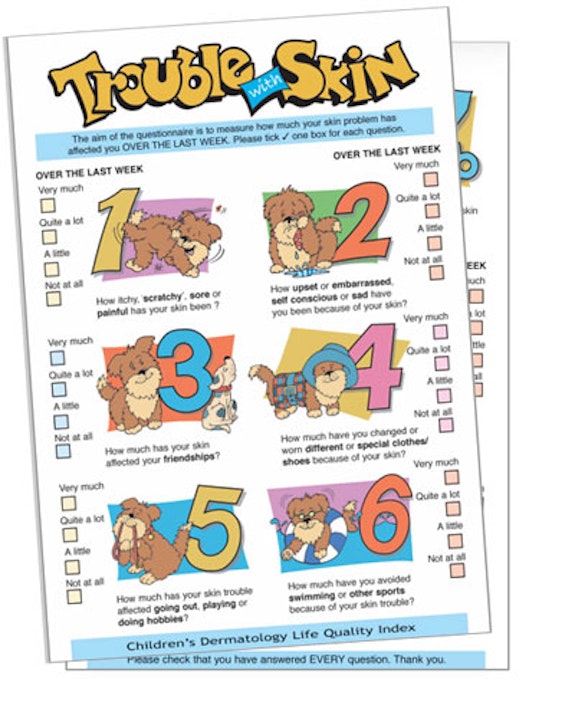Children's Dermatology Life Quality Index
The Children’s Dermatology Life Quality Index (CDLQI) and the Cartoon CDLQI are designed to measure the impact of any skin disease on the lives of children.
The questionnaires are self-explanatory and can be simply handed to the patient who is asked to fill them in with the help of the child’s parent or guardian, as necessary.
About the questionnaires

The CDLQI questionnaire was published in 1995. The 10 questions are based on the experiences of children with skin disease.
The Cartoon CDLQI is used in the same way and has nearly the exact same text as the text-only CDLQI. Each question is illustrated by a cartoon based on the theme of the question, making it more fun for younger children.
The only difference between the two formats is that the cartoon version does not have ‘prevented school’ as a response item in question 7. This was removed due to design purposes, as the cartoon CDLQI was developed to be more user friendly for younger children.
However, both versions are fully validated, and there is no difference in how respondents answer each format. Scores may be compared in any analysis.
Who can use them
These questionnaires can be used in a range of settings by clinicians, pharmaceutical companies, with-profit organisations, students or researchers.
Depending on who you are what you're using the questionnaire for, you may need to apply for a licence and pay a fee. Please note that the CLDQI and the Cartoon CDLQI have separate licences.
Learn more about who can use this questionnaire and how to administer it.
Age range
Both versions of the CDLQI have been validated from the age of four years to 16 years (i.e. up to 15 years and 11 months).
However, younger children may appreciate using the cartoon version more than older children, and some teenagers may find the cartoon version too childish; it is probably most appropriate from the ages of four years up to approximately 11-12 years.
Use outside validated age range
If you use the CDLQI outside of its validated age range, the data should be analysed and interpreted with the caveat that it is not formally validated.
For example, if in a study there is a switch from the Children's Dermatology Life Quality Index to the Dermatology Life Quality Index as soon as patients are aged 17, this presents challenges, as DLQI/CDLQI data cannot be combined, because the questions and score meaning bands are different.
Time for completion
The questionnaires are usually completed in one to two minutes.
Recall period
The questions relate to the impact of the skin disease on the child over the last week, i.e. over the last seven days.
Download the questionnaires
Children’s Dermatology Life Quality Index (CDLQI) - original UK English version (text-only)
This text-only questionnaire is designed for use in children, i.e. patients from age 4 to age 16.
If this document cannot be read by your assistive software, you can request an accessible version by emailing web@cardiff.ac.uk. Please include the assistive tools you use and the format you require.
Cartoon Children’s Dermatology Life Quality Index (CDLQI) - original UK English version
The British English version of the cartoon questionnaire, which is designed to measure the impact of any skin disease on the lives of children.
Different language versions
The zip files contain several different versions of the language (depending on what country), along with the translation certificates.
If you would like to add the cartoon images to a text-only version, please email dermqol@cardiff.ac.uk and we'll send you the high-quality JPEG/PNG files.
How to score it
The scoring of each question is:
- Very much = 3
- Quite a lot = 2
- Only a little = 1
- Not at all = 0
- Question unanswered = 0
- Question 7: 'Prevented school' (text-only questionnaire) = 3
If one question is left unanswered, this is scored 0 and the scores are summed and expressed as usual out of a maximum of 30.
If two or more questions are left unanswered, the questionnaire is not scored.
If two or more response options are ticked, the response option with the highest score should be recorded.
If there is a response between two tick boxes, the lower of the two score options should be recorded.
Meaning of scores
- 0-1 = no effect on child’s life
- 2-6 = small effect
- 7-12 = moderate effect
- 13-18 = very large effect
- 19-30 = extremely large effect
Reference: Waters A, Sandhu D, Beattie P, Ezughah F, Lewis-Jones S. Severity stratification of Children’s Dermatology Life Quality Index (CDLQI) scores. Br J Dermatol 2010; 163 (Suppl 1): 121.
Detailed analysis
The CDLQI can be analysed under six headings:
| Headings | Questions | Score |
|---|---|---|
| Symptoms and feelings | Questions 1 and 2 | Score maximum 6 |
| Leisure | Questions 4, 5 and 6 | Score maximum 9 |
| School or holidays | Question 7 | Score maximum 3 |
| Personal relationships | Questions 3 and 8 | Score maximum 6 |
| Sleep | Questions 9 | Score maximum 3 |
| Treatment | Question 10 | Score maximum 3 |
Copyright and registration
Both the CDLQI and Cartoon CDLQI are copyright worldwide, so you must not change the format, wording or design of the questionnaire.
The copyright statement for the text-only CDLQI questionnaire is:
© Children’s Dermatology Life Quality Index. M S Lewis-Jones, A Y Finlay, May 1993.
The copyright statement for the Cartoon CDLQI questionnaire is:
© M. S. Lewis-Jones, A. Y. Finlay. June 1993
Illustrations ©Media Resources Centre, UWCM. Dec 1996
The copyright statement must always be reproduced at the end of every copy of the questionnaire in whatever language. By agreement, the University now owns and administers all copyright matters relating to the CDLQI and Cartoon CDLQI.
The USA Library of Congress Registration
Number: TXU 620272
Registration date: 7 February 1994
Authors: Dr M S Lewis-Jones and Professor A Y Finlay
Publications
Original publication
Lewis-Jones MS, Finlay AY. The Children’s Dermatology Life Quality Index (CDLQI): Initial validation and practical use. British Journal of Dermatology, 1995; 132: 942-949.
Other key publications
- Salek MS, Jung S, Brincat-Ruffini LA, MacFarlane L, Lewis-Jones MS, Basra MK, Finlay AY. Clinical experience and psychometric properties of the Children's Dermatology Life Quality Index (CDLQI), 1995-2012. Br J Dermatol. 2013; 169: 734-59.
- Olsen JR, Gallacher J, Finlay AY, Piguet V, Francis NA. Quality of life impact of childhood skin conditions measured using the Children's Dermatology Life Quality Index (CDLQI): a meta-analysis. Br J Dermatol. 2016; 174: 853-61.
- van Geel MJ, Maatkamp M, Oostveen AM, de Jong EM, Finlay AY, van de Kerkhof PC, Seyger MM. Comparison of the Dermatology Life Quality Index and the Children's Dermatology Life Quality Index in assessment of quality of life in patients with psoriasis aged 16-17 years. Br J Dermatol. 2016; 174: 152-7.
- Thomas KS, Apfelbacher CA, Chalmers JR et al. Recommended core outcome instruments for health‐related quality of life, long‐term control and itch intensity in atopic eczema trials: results of the HOME VII consensus meeting. Br J Dermatol 2021.
Original publication
Holme SA, Man I, Sharpe JL, Dykes PJ, Lewis-Jones MS, Finlay AY. The Children’s Dermatology Life Quality Index: Validation of the cartoon version. British Journal of Dermatology 2003; 148: 285-290.
Other key publications
- Lewis-Jones MS, Finlay AY. The Children's Dermatology Life Quality Index (CDLQI): initial validation and practical use. Br J Dermatol, 1995; 132: 942-949.
- Beattie PE, Lewis-Jones MS. A comparative study of impairment of quality of life in children with skin disease and children with other chronic childhood diseases. Br J Dermatol 2006; 155: 145-151
- Clayton TH, Clark SM, Britton J, Pavolv S, Radev S. A comparative study of the Children’s Dermatology Life Quality Index (CDLQI) in paediatric dermatology clinics in the UK and Bulgaria. JEADV 2007; 21: 1436-1437.
Contact us
If you have any questions, or you have feedback on our web pages, please get in touch.
General queries
Dr. Faraz Ali
Dermatology Quality of Life Administrator
Financial, contractual or student enquiries
Joy Hayes
Licencing enquiries
Technology Transfer office
If you need to contact Professor Finlay
Professor Andrew Finlay
We offer a range of postgraduate dermatology courses, delivered both on site in Cardiff and online for distance-learning.

